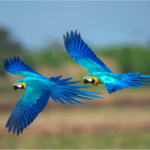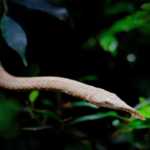This overview explores the diverse habitats of North American wildlife, from the Eastern Cottontail Rabbit’s grasslands to the marine realms of the Harbor Seal. Discover the environments these species call home, highlighting their adaptability and the ecosystems that sustain them.
Enchanted Trails: Discover Nature’s Adorable Inhabitants
Eastern Cottontail These adorable creatures are the most common rabbit species in North America, likely due to their females being able to birth up to 35 offspring a year.

Where to find: Eastern cottontails inhabit plains and shrubby areas across the USA, mainly in the eastern, south-central, and midwestern states. Keep an eye out when exploring Voyageurs National Park in northern Minnesota, 440 km north of Minneapolis.
Abert’s Squirrel (Tassel-Eared Squirrel) They may look surprised, but it’s just the tufts on their ears. Named after Colonel John James Abert, a 19th-century naturalist and surveyor who organized the mapping of the American West.

Where to find: Abert’s squirrels can be spotted in the Rocky Mountains, particularly in the plains of Arizona, New Mexico, and Colorado. You’ll find many darting around Bandelier National Monument, about 170 km north of Albuquerque, New Mexico.
Ground Squirrel Ground squirrels thrive in the heat. They survive using a “heat dump” cooling method, where they lie on the ground in shaded areas with their legs spread out.

Where to find: These squirrels are abundant in deserts and dry shrublands in the southwest. Spot them during a visit to Great Basin National Park in eastern Nevada, about 480 km north of Las Vegas, near the Utah border.
American Black Bear Black bears may look cuddly, but it’s wise to steer clear: they can run at speeds of 25 to 30 mph and weigh up to 660 lbs.

Moreover, their sense of smell is seven times greater than a dog’s, and their dexterity allows them to open screw-top jars and even door latches. Mountains, Rocky Mountains, the northern Midwest, parts of the East Coast, and Alaska. Be cautious while hiking in Green Mountain National Forest in Vermont, in the northeastern coast, about 250 km northwest of Boston, Massachusetts.
Eastern Box Turtle Look at the smile on this girl’s face (and yes, it’s a female). Male Eastern box turtles have red or orange eyes, while females have brownish-yellow eyes.

Where to find: The Eastern box turtle is found in parts of the south-central, eastern, and southeastern US. Look for them on the forest floor of the Great Smoky Mountains, stretching from the southwestern edge of North Carolina into Tennessee, about 270 km west of Charlotte, North Carolina, and 330 km east of Nashville, Tennessee.
White-tailed Deer The white-tailed deer is so common in the US that it is the state animal for nine states. Despite their delicate appearance, these animals can eat just about anything, even poison ivy.

Where to find: White-tailed deer are prevalent and can mainly be spotted in forested areas, including Shenandoah National Park in northwestern Virginia, just 115 km southwest of Washington, D.C.
Grizzly Bear Also known as brown bears (or Kodiak bears in Alaska), these majestic creatures are better admired from a distance. Grizzly bears can be aggressive, and their bite is strong enough to crush a bowling ball. During hibernation in winter, they can gain up to 400 lbs over their normal weight, reaching up to 800 lbs for some bears.

Where to find: Alaska has the largest population of grizzly bears; you can watch them fishing for salmon in the remote Katmai National Park in the southern part of the state. They are also found in Montana, Wyoming, and Idaho, especially in the Yellowstone-Teton area.
Pygmy Owl Standing only 6 to 7 inches tall, these owls are among the smallest (and cutest) in North America. They are also known for their feather markings on the back of their heads, resembling large yellow eyes to confuse predators.

Where to find: Pygmy owls are found in Alaska and the west coast, particularly at the edges of coniferous and deciduous forests. You might spot one in Sequoia National Park in central California, about 420 km southeast of San Francisco and 330 km northeast of Los Angeles.
American Pika These creatures are always on the move, gathering food for winter or carrying large amounts of dry grass and flowers in their mouths to their nests. Their bustling energy makes them endearing. Even the sound they make to alert each other of predators is cute.

Where to find: American pikas scurry around the mountains in the western half of the US. They particularly love the rocky alpine conditions of Mount Hood National Forest in Oregon, located just 100 km southeast of Portland.
Harbor Seal It’s not just tourists who enjoy lounging in the beach sun: harbor seals do too. These curious creatures weigh up to 300 lbs and are known for watching people just as much as people watch them.

Where to find: Pacific harbor seals can be found along the entire Pacific coastline. Spot them on the rocky shores of Channel Islands National Park in California, off the coast of Los Angeles. Atlantic coast seals are found from Maine to Massachusetts. Your best bet is heading to Acadia National Park on the southern coast of Maine, about 270 km northeast of Portland, Maine.
Kemp’s Ridley Turtle The Kemp’s ridley turtle is the world’s smallest marine turtle. Unfortunately, it is also among the most endangered.

Where to find: These turtles prefer the warmer waters of the Gulf of Mexico, near Florida and Louisiana, but are known to inhabit waters as far north as New Jersey. Padre Island National Seashore on the Gulf Coast in southern Texas (380 km southwest of Houston) is a great place to observe these animals; turtle hatchlings emerge in the spring or summer months.
Popular Small Pets: Rabbits and Hamsters
Among the animals listed, rabbits and hamsters are commonly kept as pets. Rabbits are valued for their trainability, as well as their social and intelligent nature. They can make excellent pets for those looking for a cuddly companion, but it’s important to note that rabbits tend to be somewhat messy and require regular cleaning of their living space.
Hamsters are also considered great pets and are known for being small, having soft fur, and cute, chubby cheeks, which are actually storage pouches. The most common species kept as a pet is the golden Syrian hamster, with over 120 varieties representing a wide range of colors and fur textures.
Both rabbits and hamsters are popular options for those looking for a small, low-maintenance pet, suitable for spaces like apartments. They require daily care and attention but are generally considered less demanding than larger pets such as dogs and cats.
Wild Animals Not Suitable for Pets: A Cautionary Note
Among the animals previously mentioned, those that should never be kept as pets include American black bears, grizzly bears, pygmy owls, and possibly others, due to their wild nature and specific needs that cannot be adequately met in a domestic setting.
Keeping wild animals as pets can lead to serious animal welfare issues, in addition to health risks to humans due to zoonotic diseases. Furthermore, wild animals, even those born in captivity, do not become domesticated and can display behaviors indicative of emotional trauma, such as self-mutilation observed in parrots or repetitive destructive behaviors seen in captive otters and sugar gliders.
Moreover, wild animals kept as pets can pose a direct danger to humans. There have been instances of attacks and even fatalities involving owners of wild animals kept as pets, demonstrating that these animals retain their wild instincts and can become aggressive or unpredictable.
Therefore, it is strongly recommended to opt for domesticated animals, such as dogs and cats, which have been selected over thousands of years to live in harmony with humans, with their needs well understood and fully met in a domestic environment.
Habitats of North American Wildlife: An Overview
Eastern Cottontail Rabbit – The Eastern Cottontail Rabbit thrives in mixed landscapes with meadows, grasslands, thickets, and woodlands. They prefer environments where open spaces blend into areas with dense cover to provide shelter and foraging grounds.
Abert’s Squirrel – Abert’s Squirrel, also known as the tassel-eared squirrel, primarily inhabits the ponderosa pine forests in the Southwestern United States. These squirrels are closely associated with ponderosa pines, depending on them for food and habitat.
Ground Squirrel – Ground Squirrels are found in a variety of habitats, including grasslands, open woodlands, and deserts. They prefer areas that offer easy digging for their burrows and a good lookout for predators.
American Black Bear – The American Black Bear’s natural habitat includes forests, swamps, and areas with dense brush. They are adaptable and can also be found in mountainous regions and even in the outskirts of urban areas.
Eastern Box Turtle – Eastern Box Turtles reside in moist forested areas, with a preference for deciduous or mixed woodlands. They also adapt to grasslands and marshy meadows, as long as there is sufficient cover and moisture.
White-Tailed Deer – White-Tailed Deer are adaptable and can live in a variety of habitats but prefer areas with dense thickets for cover and open fields for feeding. Their habitats range from forests and meadows to agricultural lands and brushy areas.
Grizzly Bear – Grizzly Bears are found in dense forests, subalpine meadows, and alpine tundra. They require large expanses of wildland for foraging, mating, and denning, often roaming in areas that span national parks and wilderness.
Northern Pygmy Owl – The Northern Pygmy Owl inhabits open coniferous forests and mixed woodlands, often with clearings or edges. They are found at various elevations, from sea level to the treeline.
American Pika – American Pikas live in alpine and subalpine zones, primarily in rocky talus fields and boulder-strewn mountain slopes. They require cold climates and are sensitive to overheating, thus staying at high elevations.
Harbor Seal – Harbor Seals are found along temperate and Arctic marine coastlines of the Northern Hemisphere. They prefer sandy beaches, rocky shores, and glacial fjords for hauling out and breeding.
Kemp’s Ridley Sea Turtle – Kemp’s Ridley Sea Turtles predominantly inhabit the coastal and marine environments of the Gulf of Mexico and the Atlantic. They prefer shallow waters with sandy or muddy bottoms for foraging.
Each description offers insight into the natural environments these animals call home, emphasizing their unique adaptations and preferences within their respective ecosystems.
Join the Movement: Share Your Wildlife Stories & Protect Nature
Have you ever been graced by the unexpected company of wildlife on your trails? Your stories can inspire and ignite a collective effort towards safeguarding these precious encounters. Join the conversation below and let’s empower each other to protect our natural companions!
For a blog focused on environmental preservation in the US, you might find The Nature Conservancy’s website valuable. They are dedicated to effective, lasting conservation efforts in over 70 countries and territories, focusing on tackling climate change, protecting lands and waters, and providing sustainable solutions for food and water. For more details, you can explore their initiatives and how you can get involved on their site at The Nature Conservancy.

Join Marjorie Pearson at dwfocus.com, your guide in the pet parenting world. As an experienced animal behaviorist, Marjorie offers heartfelt advice for pet owners. Her expertise spans from nurturing kittens to understanding dogs’ playful antics. She’s passionate about enhancing the bond between pets and their humans through understanding and empathy. Discover Marjorie’s practical training tips and insights on dwfocus.com, enriching your journey as a pet owner. #4PawsAndOwners #MarjorieEarsonPetWhisperer #dwfocus







